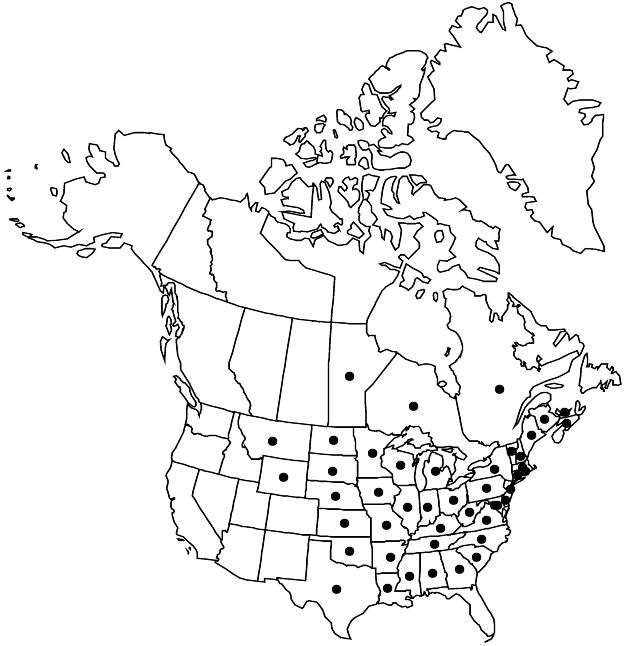Difference between revisions of "Geum canadense"
Hort. Bot. Vindob. 2: 82, plate 175. 1772–1773.
FNA>Volume Importer |
FNA>Volume Importer |
||
| Line 12: | Line 12: | ||
|name=Geum camporum | |name=Geum camporum | ||
|authority=Rydberg | |authority=Rydberg | ||
| + | |rank=species | ||
}} {{Treatment/ID/Synonym | }} {{Treatment/ID/Synonym | ||
|name=G. canadense var. brevipes | |name=G. canadense var. brevipes | ||
|authority=Fernald | |authority=Fernald | ||
| + | |rank=variety | ||
}} {{Treatment/ID/Synonym | }} {{Treatment/ID/Synonym | ||
|name=G. canadense var. camporum | |name=G. canadense var. camporum | ||
|authority=(Rydberg) Fernald & Weatherby | |authority=(Rydberg) Fernald & Weatherby | ||
| + | |rank=variety | ||
}} {{Treatment/ID/Synonym | }} {{Treatment/ID/Synonym | ||
|name=G. canadense var. grimesii | |name=G. canadense var. grimesii | ||
|authority=Fernald & Weatherby | |authority=Fernald & Weatherby | ||
| + | |rank=variety | ||
}} {{Treatment/ID/Synonym | }} {{Treatment/ID/Synonym | ||
|name=G. canadense var. texanum | |name=G. canadense var. texanum | ||
|authority=Fernald & Weatherby | |authority=Fernald & Weatherby | ||
| + | |rank=variety | ||
}} | }} | ||
|hierarchy=Rosaceae;Rosaceae subfam. Rosoideae;Rosaceae tribe Colurieae;Geum;Geum canadense | |hierarchy=Rosaceae;Rosaceae subfam. Rosoideae;Rosaceae tribe Colurieae;Geum;Geum canadense | ||
| Line 39: | Line 44: | ||
|elevation=0–600 m | |elevation=0–600 m | ||
|distribution=Man.;N.B.;N.S.;Ont.;P.E.I.;Que.;Ala.;Ark.;Conn.;Del.;D.C.;Ga.;Ill.;Ind.;Iowa;Kans.;Ky.;La.;Maine;Md.;Mass.;Mich.;Minn.;Miss.;Mo.;Mont.;Nebr.;N.H.;N.J.;N.Y.;N.C.;N.Dak.;Ohio;Okla.;Pa.;R.I.;S.C.;S.Dak.;Tenn.;Tex.;Vt.;Va.;W.Va.;Wis.;Wyo.;Mexico (Chiapas). | |distribution=Man.;N.B.;N.S.;Ont.;P.E.I.;Que.;Ala.;Ark.;Conn.;Del.;D.C.;Ga.;Ill.;Ind.;Iowa;Kans.;Ky.;La.;Maine;Md.;Mass.;Mich.;Minn.;Miss.;Mo.;Mont.;Nebr.;N.H.;N.J.;N.Y.;N.C.;N.Dak.;Ohio;Okla.;Pa.;R.I.;S.C.;S.Dak.;Tenn.;Tex.;Vt.;Va.;W.Va.;Wis.;Wyo.;Mexico (Chiapas). | ||
| − | |discussion=<p>Varieties and forms have been described in an effort to classify the variation encompassed in <i>Geum canadense</i>. In the eastern half of the United States, it is by far the most common, widespread, and variable of the <i>Geum</i> species. Nearly all writers of recent floras have not found it worthwhile to apply names to the variants. Perhaps the most distinctive and worthy of further consideration are plants from the southwestern corner of the range in Arkansas, Oklahoma, and Texas. These plants, some of which fit Fernald and Weatherby’s description of < | + | |discussion=<p>Varieties and forms have been described in an effort to classify the variation encompassed in <i>Geum canadense</i>. In the eastern half of the United States, it is by far the most common, widespread, and variable of the <i>Geum</i> species. Nearly all writers of recent floras have not found it worthwhile to apply names to the variants. Perhaps the most distinctive and worthy of further consideration are plants from the southwestern corner of the range in Arkansas, Oklahoma, and Texas. These plants, some of which fit Fernald and Weatherby’s description of <i></i>var.<i> texanum</i>, bloom from late March through May, significantly earlier than the rest of the species, which typically flowers after June first, even in the other southern states.</p><!-- |
--><p><i>Geum canadense</i> hybridizes with <i>G. urbanum</i> (= G. ×catlingii J.-P. Bernard & R. Gauthier); see discussion under 15. <i>G. urbanum</i>.</p><!-- | --><p><i>Geum canadense</i> hybridizes with <i>G. urbanum</i> (= G. ×catlingii J.-P. Bernard & R. Gauthier); see discussion under 15. <i>G. urbanum</i>.</p><!-- | ||
--><p><i>Geum</i> album J. F. Gmelin is a superfluous name that pertains here.</p> | --><p><i>Geum</i> album J. F. Gmelin is a superfluous name that pertains here.</p> | ||
| Line 53: | Line 58: | ||
-->{{#Taxon: | -->{{#Taxon: | ||
name=Geum canadense | name=Geum canadense | ||
| − | |||
|authority=Jacquin | |authority=Jacquin | ||
|rank=species | |rank=species | ||
| Line 68: | Line 72: | ||
|publication year=1773 | |publication year=1773 | ||
|special status= | |special status= | ||
| − | |source xml=https://jpend@bitbucket.org/aafc-mbb/fna-data-curation.git/src/ | + | |source xml=https://jpend@bitbucket.org/aafc-mbb/fna-data-curation.git/src/f50eec43f223ca0e34566be0b046453a0960e173/coarse_grained_fna_xml/V9/V9_100.xml |
|subfamily=Rosaceae subfam. Rosoideae | |subfamily=Rosaceae subfam. Rosoideae | ||
|tribe=Rosaceae tribe Colurieae | |tribe=Rosaceae tribe Colurieae | ||
Revision as of 22:37, 16 December 2019
Plants leafy-stemmed. Stems 30–100 cm, glabrate to downy, hairs to 1.5 mm, sometimes glandular. Leaves: basal 10–25 cm, blade simple or pinnate, major leaflets 3–5, plus 0–4 minor basal ones, terminal leaflet larger than major laterals; cauline 3–8 cm, stipules ± free, 4–13 × 1–7 mm, blade 3-foliolate or simple and 3-lobed to unlobed. Inflorescences 3–15-flowered. Pedicels densely hairy, hairs of varying lengths, few long stiff ones, sometimes glandular. Flowers erect; epicalyx bractlets 0.5–1.5 mm; hypanthium green; sepals spreading but soon reflexed, 3–6 mm; petals spreading, white, obovate to oblong, (3–)4–8 mm, ± equal to or slightly longer than sepals, apex rounded. Fruiting tori sessile, densely bristly, hairs 1–2.3 mm. Fruiting styles geniculate-jointed, proximal segment persistent, 2–8 mm, apex hooked, usually glabrous, sometimes sparsely hairy or stipitate-glandular, distal segment deciduous, 1–2 mm, pilose in basal 1/2, hairs much longer than diam. of style. 2n = 42.
Phenology: Flowering spring–summer.
Habitat: Lowlands and upland forests, meadows, along streams, thickets, bottomland hardwoods, swamps
Elevation: 0–600 m
Distribution

Man., N.B., N.S., Ont., P.E.I., Que., Ala., Ark., Conn., Del., D.C., Ga., Ill., Ind., Iowa, Kans., Ky., La., Maine, Md., Mass., Mich., Minn., Miss., Mo., Mont., Nebr., N.H., N.J., N.Y., N.C., N.Dak., Ohio, Okla., Pa., R.I., S.C., S.Dak., Tenn., Tex., Vt., Va., W.Va., Wis., Wyo., Mexico (Chiapas).
Discussion
Varieties and forms have been described in an effort to classify the variation encompassed in Geum canadense. In the eastern half of the United States, it is by far the most common, widespread, and variable of the Geum species. Nearly all writers of recent floras have not found it worthwhile to apply names to the variants. Perhaps the most distinctive and worthy of further consideration are plants from the southwestern corner of the range in Arkansas, Oklahoma, and Texas. These plants, some of which fit Fernald and Weatherby’s description of var. texanum, bloom from late March through May, significantly earlier than the rest of the species, which typically flowers after June first, even in the other southern states.
Geum canadense hybridizes with G. urbanum (= G. ×catlingii J.-P. Bernard & R. Gauthier); see discussion under 15. G. urbanum.
Geum album J. F. Gmelin is a superfluous name that pertains here.